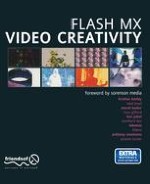by Bruce Herbert and Diana Johnson ofSorenson Media Creative boundaries are being blown apart as Macromedia Flash MX ushers in a new era of moving images on the Internet. At its launch, analysts predicted that the Flash Player would transform itself from being a lightweight animation tool" to "the de facto technology for simple web interactivity5* (Randy Souza, Forrester). Since then though, Flash developers combining vector animation and video have proven that it's capable of much, much more than "simple web interactivity". We're still just beginning to scratch the surface of the possibilities it opens up to us, but already it looks like Flash MX is becoming the key technology for pushing video creativity on the Web to a new whole level. Understandably, many people look at Flash as just another way to deliver video on the Web, one more program for showing movies on your desktop. Well, it can certainly do that - but there's a whole lot more it can do besides! You can use ActionScript to add custom controls, determine a video playback sequence, or mask your video with a custom shape. You can use layering to create special effects, design custom templates for e-learning applications, and use lightweight video streams along with Flash animation in rich media e-mail campaigns.
